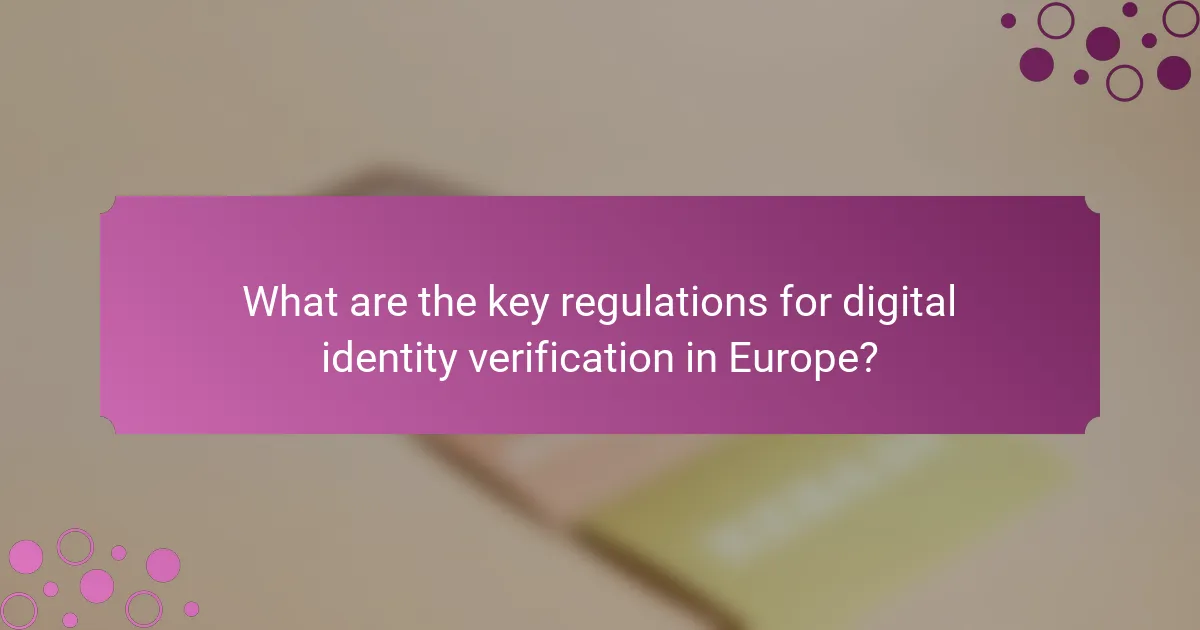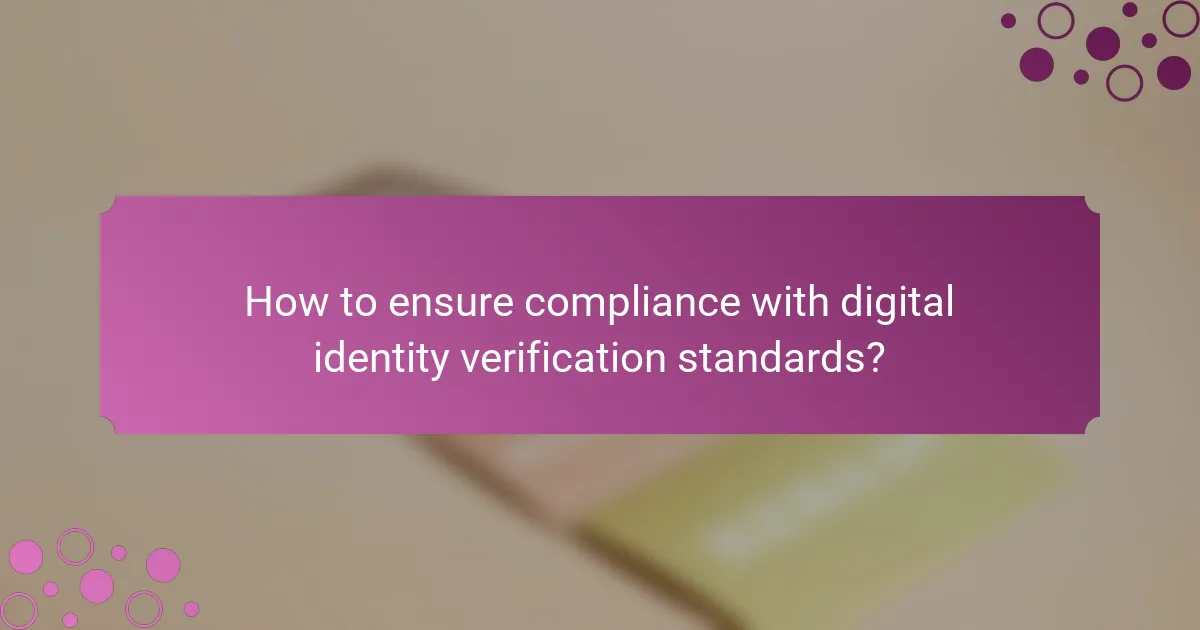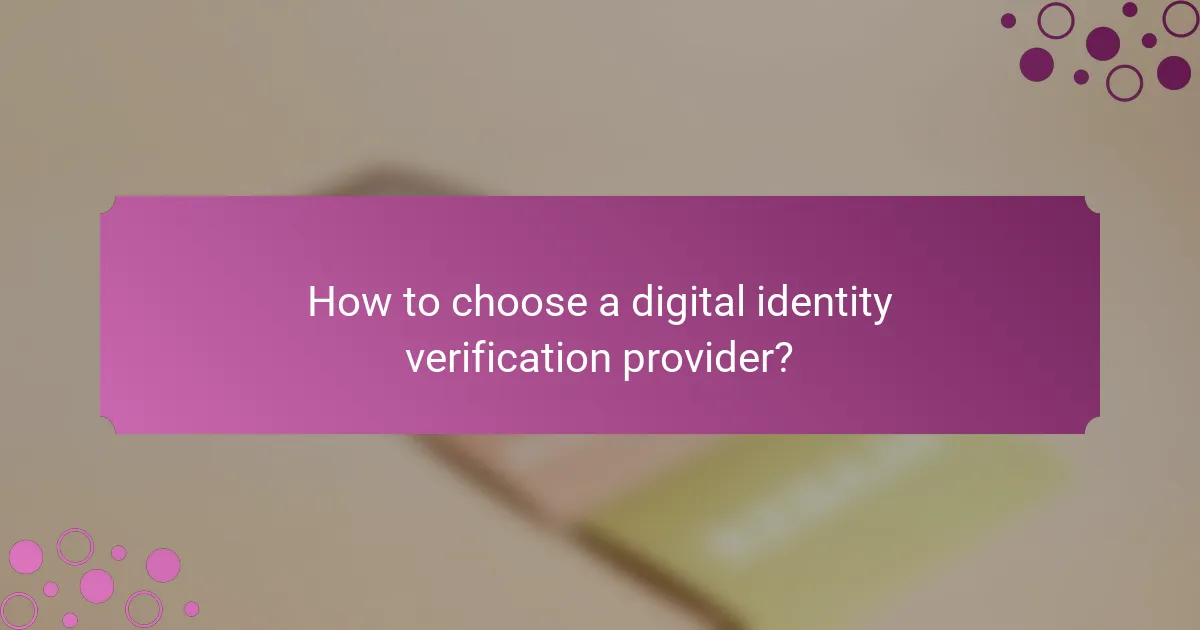Digital identity verification in Europe is governed by a framework of regulations such as the GDPR, eIDAS, AMLD, and PSD2, which collectively aim to protect personal data and ensure secure transactions. Organizations must adopt a structured compliance approach that incorporates risk-based strategies and certified solutions while adhering to industry best practices. By focusing on security measures like multi-factor authentication and data minimization, businesses can effectively navigate the complexities of regulatory compliance and enhance user trust.

What are the key regulations for digital identity verification in Europe?
In Europe, key regulations for digital identity verification include the General Data Protection Regulation (GDPR), eIDAS Regulation, Anti-Money Laundering Directive (AMLD), and Payment Services Directive 2 (PSD2). These regulations establish standards for data protection, electronic identification, anti-fraud measures, and secure payment processes.
General Data Protection Regulation (GDPR)
The GDPR is a comprehensive data protection regulation that governs how personal data should be handled across Europe. It mandates that organizations obtain explicit consent from individuals before processing their data and ensures that users have rights over their information, including access and deletion.
For digital identity verification, compliance with GDPR means implementing strong data security measures and ensuring transparency in data processing. Organizations must conduct Data Protection Impact Assessments (DPIAs) to identify risks associated with personal data handling.
eIDAS Regulation
The eIDAS Regulation establishes a framework for electronic identification and trust services across EU member states. It aims to enhance the security and efficiency of online transactions by providing a standardized approach to digital identities.
Under eIDAS, qualified electronic signatures and seals are legally recognized, which facilitates cross-border transactions. Businesses must ensure their digital identity verification processes align with eIDAS standards to gain trust and comply with legal requirements.
Anti-Money Laundering Directive (AMLD)
The AMLD aims to prevent money laundering and terrorist financing by requiring businesses to implement Know Your Customer (KYC) procedures. This involves verifying the identity of clients and assessing the risks associated with their transactions.
For digital identity verification, organizations must collect and verify identity documents, monitor transactions, and report suspicious activities. Compliance with AMLD helps mitigate risks and enhances the integrity of financial systems.
Payment Services Directive 2 (PSD2)
PSD2 is a regulation that enhances the security of electronic payments and promotes innovation in the payment services market. It requires strong customer authentication (SCA) for online transactions, which often involves multi-factor authentication methods.
To comply with PSD2, businesses must implement secure digital identity verification processes that protect customer data while facilitating seamless transactions. This regulation encourages the use of APIs to enable third-party providers to access payment accounts, fostering competition and improving services.

How to ensure compliance with digital identity verification standards?
To ensure compliance with digital identity verification standards, organizations must adopt a structured approach that aligns with regulatory requirements and industry best practices. This involves implementing risk-based strategies, utilizing certified solutions, and conducting regular audits to maintain adherence to evolving standards.
Implementing risk-based approaches
Risk-based approaches prioritize identity verification efforts based on the potential risk associated with different transactions or user profiles. Organizations should assess factors such as transaction value, user behavior, and geographic location to determine the level of verification required.
For example, high-value transactions may necessitate more stringent verification methods, while low-risk transactions could use simpler processes. This tailored approach helps balance security and user experience, ensuring compliance without overburdening legitimate users.
Utilizing certified identity verification solutions
Using certified identity verification solutions is crucial for compliance with digital identity standards. These solutions often adhere to established regulations, such as the EU’s General Data Protection Regulation (GDPR) and the Anti-Money Laundering (AML) directives.
Organizations should select providers that offer solutions certified by recognized bodies, ensuring they meet necessary security and privacy standards. This not only enhances compliance but also builds trust with users, as they can be confident their data is handled securely.
Regular compliance audits
Conducting regular compliance audits is essential for maintaining adherence to digital identity verification standards. These audits help identify gaps in processes and ensure that the organization remains aligned with current regulations and best practices.
Audits should include a review of verification processes, data handling practices, and user feedback. Organizations can establish a schedule for these audits, such as quarterly or bi-annually, to ensure ongoing compliance and to adapt to any regulatory changes promptly.

What are best practices for digital identity verification in Europe?
Best practices for digital identity verification in Europe focus on enhancing security while ensuring compliance with regulations. Key strategies include implementing multi-factor authentication, continuous monitoring of identity data, and employing data minimization techniques to protect user privacy.
Multi-factor authentication
Multi-factor authentication (MFA) adds an extra layer of security by requiring users to provide two or more verification factors to access their accounts. This could include something they know (like a password), something they have (like a smartphone app), or something they are (like a fingerprint). In Europe, MFA is often mandated under regulations such as the EU’s Payment Services Directive 2 (PSD2).
To implement MFA effectively, organizations should choose methods that are user-friendly and widely accessible. For example, SMS codes or authenticator apps are common choices. Avoid relying solely on email for verification, as it can be less secure.
Continuous monitoring of identity data
Continuous monitoring of identity data involves regularly reviewing and updating user information to detect any anomalies or unauthorized changes. This practice helps organizations maintain the integrity of their identity verification processes and respond quickly to potential fraud. In Europe, compliance with the General Data Protection Regulation (GDPR) requires organizations to ensure that personal data is accurate and up to date.
Organizations should establish a routine for monitoring identity data, which may include automated alerts for suspicious activities. Regular audits can also help identify gaps in security and compliance, ensuring that identity verification measures remain robust.
Data minimization techniques
Data minimization techniques focus on collecting only the information necessary for identity verification, thereby reducing the risk of data breaches and enhancing user privacy. Under GDPR, organizations are required to limit data collection to what is essential for their purposes. This means avoiding excessive data requests during the verification process.
To apply data minimization, businesses can implement strategies such as asking for the least amount of personal information required for verification or using pseudonymization techniques. Regularly reviewing data collection practices can help ensure compliance and protect user privacy.

How to choose a digital identity verification provider?
Choosing a digital identity verification provider involves assessing their compliance with regulations, technology capabilities, and support services. Prioritize providers that meet industry standards and can integrate seamlessly with your existing systems while offering reliable customer support.
Evaluating provider certifications
Start by checking if the provider holds relevant certifications, such as ISO 27001 for information security management or eIDAS compliance in Europe. These certifications indicate adherence to recognized standards in data protection and identity verification.
Look for providers that have undergone third-party audits to validate their claims. This adds an extra layer of assurance regarding their operational integrity and compliance with European regulations.
Assessing technology compatibility
Ensure that the digital identity verification provider’s technology is compatible with your existing systems. This includes evaluating APIs, data formats, and integration capabilities to facilitate a smooth implementation process.
Consider the scalability of the technology as well. A provider that can handle increased volumes of verification requests without compromising performance is essential for growing businesses.
Reviewing customer support options
Examine the customer support options available from the provider. Look for 24/7 support, multiple contact methods (such as phone, email, and chat), and a dedicated account manager for personalized assistance.
Additionally, assess the provider’s response times and the availability of resources such as FAQs, documentation, and training materials. Strong support can significantly enhance your experience and ensure smooth operations during implementation and beyond.

What are the emerging trends in digital identity verification?
Emerging trends in digital identity verification focus on enhancing security, user experience, and compliance with regulations. Innovations such as biometric verification, decentralized identity solutions, and AI-driven fraud detection are reshaping how organizations authenticate identities.
Biometric verification advancements
Biometric verification is increasingly utilized for its accuracy and convenience. Technologies like facial recognition, fingerprint scanning, and iris recognition are becoming standard in various sectors, including banking and healthcare. These methods often provide quick authentication, typically within seconds, enhancing user experience while maintaining security.
However, organizations must consider privacy implications and regulatory compliance when implementing biometric systems. Ensuring data protection and obtaining user consent are critical steps to avoid legal issues and build trust with users.
Decentralized identity solutions
Decentralized identity solutions empower users by allowing them to control their personal data without relying on a central authority. This approach leverages blockchain technology to create secure, verifiable identities that can be shared selectively. Users can manage their credentials, reducing the risk of data breaches associated with centralized databases.
Adopting decentralized identity systems can enhance privacy and security, but organizations should be aware of the technical complexities involved. Integration with existing systems and user education are essential for successful implementation.
AI-driven identity fraud detection
AI-driven identity fraud detection employs machine learning algorithms to analyze patterns and identify suspicious activities in real-time. These systems can flag anomalies based on user behavior, transaction history, and other data points, significantly reducing the risk of fraud. Many organizations report improved detection rates and faster response times with AI tools.
While AI offers powerful capabilities, it is crucial to continually update algorithms and training data to adapt to evolving fraud tactics. Organizations should also ensure transparency in AI decision-making processes to maintain user trust and comply with regulations.

What are the challenges in digital identity verification compliance?
Digital identity verification compliance faces several challenges, including regulatory complexity, technological limitations, and user privacy concerns. Organizations must navigate varying regulations across Europe while ensuring robust security measures and maintaining user trust.
Regulatory Complexity
Regulatory complexity is a significant challenge in digital identity verification compliance. Different countries in Europe have distinct regulations, such as the General Data Protection Regulation (GDPR) and the eIDAS Regulation, which govern how personal data is handled and verified. Organizations must stay informed about these regulations to ensure compliance and avoid hefty fines.
To manage regulatory complexity, businesses should implement a compliance framework that regularly reviews and updates their practices. This may involve appointing a compliance officer or utilizing compliance management software to track changes in regulations across jurisdictions.
Technological Limitations
Technological limitations can hinder effective digital identity verification. Many organizations rely on outdated systems that may not support advanced verification methods, such as biometric authentication or machine learning algorithms. This can lead to inefficiencies and increased risk of fraud.
To overcome these limitations, organizations should invest in modern identity verification technologies. Solutions that integrate artificial intelligence and machine learning can enhance accuracy and speed in verifying identities, ultimately improving compliance and user experience.
User Privacy Concerns
User privacy concerns are paramount in digital identity verification compliance. Individuals are increasingly wary of how their personal data is collected, stored, and used. Organizations must balance the need for verification with the obligation to protect user privacy.
To address these concerns, businesses should adopt transparent data practices. This includes clearly communicating how data will be used, obtaining explicit consent, and implementing strong data protection measures. Regularly conducting privacy impact assessments can also help identify and mitigate potential risks to user privacy.

